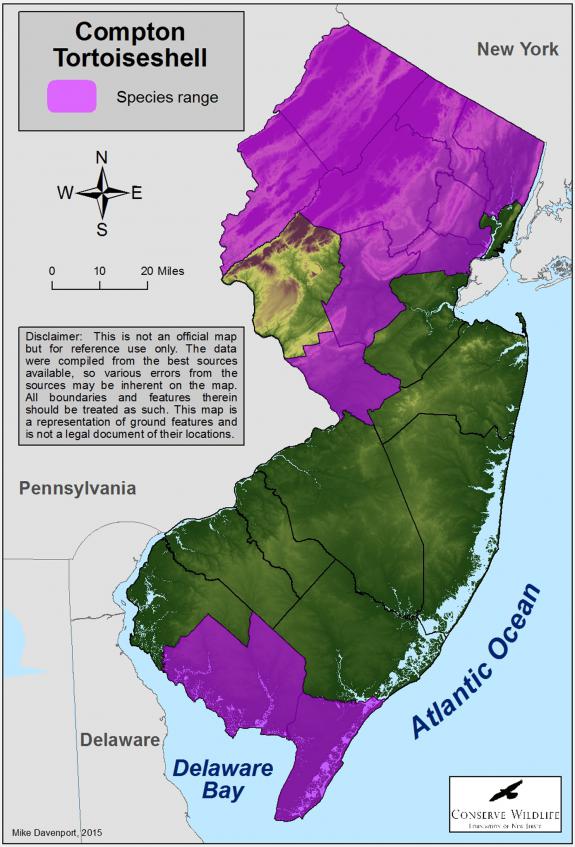Nymphalis l-album
Type: invertebrate
Status: special concern
Species Guide
Compton tortoiseshell
Nymphalis l-album
Species Type: invertebrate
Conservation Status: special concern
IDENTIFICATION
The Compton tortoiseshell has a wingspan of approximately 2 ½ to 3 inches. The upper sides of its wings are orange brown with black spots, with the color getting darker toward the wing base. There is a single white spot on the leading edge of the forewings and hindwings. The underside of the wing is mottled brown and gray with darker coloring at the wing base and borders. There is a small white “V” on the underside of the hindwing.
Larvae are pale green with black and white speckling. There are rows of branched black spines running along the larvae’s back.

Distribution & Habitat
Compton tortoiseshell butterflies are found in the northern hemisphere from southeastern Alaska and Canada to Montana and Wyoming, east to New England and south along the eastern United States to North Carolina. Rare sightings have been reported outside of this range in Newfoundland, Florida, and Nebraska. In New Jersey, it is most common in the northeast of the state, but can be found occasionally in the central region where there are areas of mature deciduous forest.
The Compton tortoiseshell is a woodland species found in upland mixed and deciduous forests where it can overwinter in tree cavities. In developed areas, it can be found under building eaves and in garages.
Diet
Larvae of the Compton tortoiseshell feed on willows (Salix spp.), aspens (Populus spp.), and birches (Betula spp.).
As this butterfly rarely consumes nectar, flowers are not a habitat necessity; however, nectar from willow flowers can be a part of the diet of adult butterflies. Their diets also consist of rotting fruit and sap.
Life Cycle
In late March through May, mating occurs and the female deposits a cluster of eggs on the leaves of a food plant. The eggs are yellow and dome shaped with eight ridges converging at a depression. Once hatched, the larvae feed in aggregations and mature until they form a chrysalis. Pupation in the chrysalis lasts about two weeks in mid to late June.
Compton tortoiseshells overwinter as adults. They take shelter in tree cavities, under tree bark, in crevices in rocks, or in buildings. This occurs both singly and in aggregations. Its flight period lasts from March to November.
Current Threats, Status, and Conservation
While they are generally common within their range, the Compton tortoiseshell is recommended for listing as a “special concern” species in New Jersey. This means that they are especially vulnerable to habitat destruction or modification. Numbers in a population are known to fluctuate from year to year depending on reproductive success for a population. This can be impacted by climate factors.
In addition, development of the mature forests the butterfly needs to survive can have a negative impact on the species. As larvae rely on specific host trees to develop and survive, the removal of these trees from an environment leaves less suitable habitat for larval development.
In 2015, the New Jersey Endangered and Nongame Advisory Committee recommended a Special Concern status for this species within the state. A rule change was adopted in January 2025 which updated this species status as special concern.
References
- Butterflies and Moths of North America
- Canadian Biodiversity Information Facility
- Massachusetts Audubon Society
- North American Butterfly Association, New Jersey Chapter
Text written by Kathleen Wadiak in 2015.
Scientific Classification
- Kingdom: Animalia
- Phylum: Arthropoda
- Class: Insecta
- Order: Lepidoptera
- Family: Nymphalidae
- Genus: Nymphalis
- Species: N. l-album